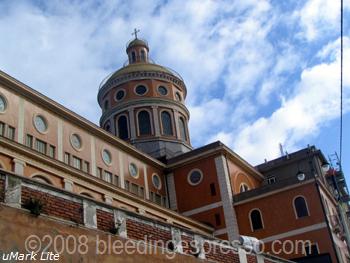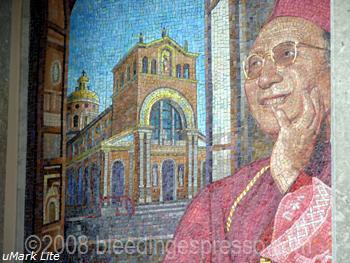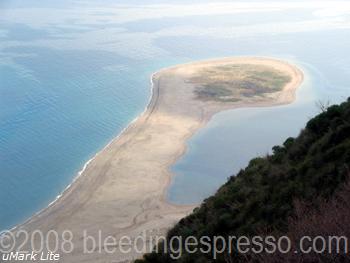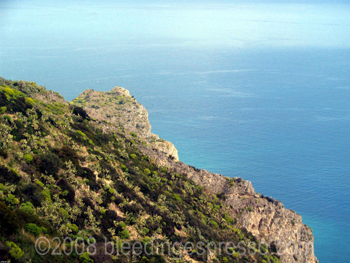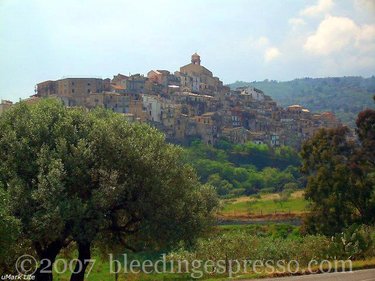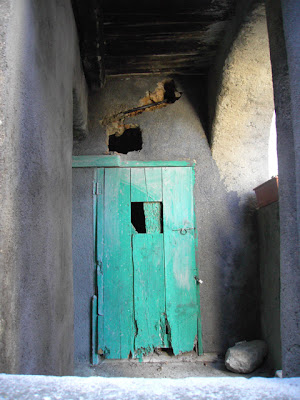Archive for the ‘the sea’ Category
The Legend of Fata Morgana
 You’re relaxing in the Strait of Messina between Calabria and Sicily, enjoying the perfectly still water and air.
You’re relaxing in the Strait of Messina between Calabria and Sicily, enjoying the perfectly still water and air.
All is right with the world, you think, as you sip the local red.
You gaze into the glistening water and suddenly you feel like you’re closer to the island of Sicily than you thought you were. Indeed, it looks like you could reach out and touch it!
Is this what a sun stroke feels like?
Have you enjoyed a bit too much vino?
The history of southern Italy goes back as far as civilization itself, and so do many of her superstitions (malocchio anyone?) and myths–including the famous legend of the Fata Morgana, the Fairy Morgan, half-sister of King Arthur.
The story goes that as Roger de Hauteville sat on the coast of our bella Calabria dreaming of a Norman conquering of Sicily, he caught a whiff of orange blossoms and heard celebratory music coming from the Tyrrhenian Sea.
A hermit (clearly breaking Hermit Code) informed Roger that the melodies arose from Sicily, where Saracens were dancing and partying as Christians suffered in slavery.
 Roger wanted to go over immediately, but he didn’t have ships to cross the Strait (and dang it, there was no ferry at the time). So he sat some more on the beach, as many of us do, wondering what to do next.
Roger wanted to go over immediately, but he didn’t have ships to cross the Strait (and dang it, there was no ferry at the time). So he sat some more on the beach, as many of us do, wondering what to do next.
Improvvisamente a fairy with a magical coach and seven white horses appeared before him and offered to transport him to the island.
Roger refused her help, which angered the Fairy Morgan. In retaliation, she threw three stones into the sea making Sicily appear achingly within the reach of Roger.
He stood his ground, though, and proclaimed that he didn’t need the help of some fairy to conquer Sicily–all he needed was the help of Jesus Christ!
The fairy and her illusions disappeared, and later on, Roger did get to Sicily with his own ships and conquered the island in the name of Jesus Christ.
Indeed, he is now known as Roger I of Sicily.
It is said that the image seen by Roger still appears off the coast of Reggio Calabria often on mornings following cold nights when there is calm, still air and water. The shore of Sicily appears reflected in and above the sea, with buildings lengthened and deformed, depicting a colorful, moving, magical city of Messina.
This meteorological (and some say mythical) mirage is knows as the Fata Morgana, and she patiently awaits your arrival. You have to buy the wine though.
The Sanctuary of the Black Madonna in Tindari, Sicily
* Have you joined The Ultimate Blog Party? See my welcome post here! *
We’re back in Sicily today, dear readers, to visit Tindari (Tyndaris), an ancient Greek settlement in the comune of Patti.
I’ll tell you more about the history of this once vibrant city overlooking the Tyrrhenian Sea another day when we tour the ruins of Tindari, but today’s feature is the Sanctuary of the Black Madonna (Santuario della Madonna Nera).
The original church, which had been built on top of the old city’s ruins, was destroyed by Algerian pirates in 1544, then reconstructed between 1552 and 1598; the sanctuary was expanded in 1979 when a new, larger church was built on the site.
The whole grounds are just lovely; indeed, here is a fabulous mosaic that you’ll see on the walk up to the church doors. I don’t know who he is, but he sure looks peaceful and content, doesn’t he?
I should mention that the phenomenon of Black Madonnas around the world is interesting in and of itself, and you can read more about it here.
The Black Madonna in Tindari, carved of cedar, has a few legends attached to her, some of which include how she got there in the first place.
One legend says that sailors, having sought refuge from a storm in the bay of Tindari, found themselves unable to ship back out to sea.
They began unloading their cargo little by little until they realized that it was the Black Madonna herself that needed to stay in Tindari, so they carried her up to the small church on the hill, and she has remained there ever since.
Another legend says that the statue was brought from the Middle East (its likely origin regardless of how it ended up in Tindari) to protect Sicily during the Iconoclastic Wars in the 8th century.
And these aren’t the only legends surrounding the Black Madonna. See this lagoon?
It is said to have been created when a mother coming to visit the sanctuary refused to pray to the Madonna because she was black. When the woman’s baby slipped from her grasp into the sea below, the Madonna made parts of the land rise to save the baby and the lagoon was born.
Another interesting feature of the Madonna Nera is the inscription “Nigra sum sed formosa” at the base of the statue. It means “I am black but beautiful” and comes from the Old Testament’s Song of Songs, although the precise relationship between the biblical phrase and the Black Madonna is widely debated.
Some of you from the New York/New Jersey area may have already heard of the Black Madonna of Tindari as Sicilian immigrants have honored her since the early 20th century–for more information on this connection, check out a great article by Joseph Sciorra discussing the history of The Black Madonna of East Thirteenth Street as well as a short piece from The New York Times.
And, before we go, another gorgeous view looking down from the Sanctuary:
Pure tranquility and beauty in Tindari.
I highly recommend a visit.
expat countdown meme
 My fellow American in Calabria, Cherrye of My Bella Vita, did this meme a looooong time ago, but I’m just getting around to it.
My fellow American in Calabria, Cherrye of My Bella Vita, did this meme a looooong time ago, but I’m just getting around to it.
She got it from Expat Travels: From Switzerland to Canada (where I saw it as well) who got it from The CanadianSwiss Blog…and as I’ve been promising Diane of Martinis for Two that I’d talk a bit more about my expat feelings, I figured now was as good a time as any to do this one.
* Name 5 things you love in your new country:
- Knowing that a neighbor always has something I need–parsley, lemons, tomatoes, gossip (yes, even things I don’t need!).
- The sea, the sea, the beautiful Ionian Sea and the mountains, the mountains, the gorgeous mountains–all from my balcony!
- Fresh, organic food that is readily available and relatively inexpensive.
- Clean, fresh air.
- Not having to worry about health insurance.
* Name 4 things that you miss from your native country:
- My family and friends, of course.
- Ethnic food of any kind other than Italian/Calabrian.
- Jeans that I like and that fit me well.
- American sports, especially watching my Duke Blue Devils this time of year (and especially *especially* when they beat Carolina).
* Name 3 things that annoy you a bit (or much) in your new country:
- Silvio Berlusconi.
- The pathetic salaries in sharp contrast to the high cost of living.
- Did I mention Berlusconi?
* Name 2 things that surprise you (or have surprised you in the beginning) in your new country:
- How difficult it has been to get to know Italian women as friends.
- The entire Italian education system, including how long it takes many to get through university.
* Name 1 thing that you would terribly miss in your new country, if you had to leave it.
- Well, P of course, but also the Italian language. I’m not sure I could do without it anymore. I came here knowing nothing, but now I’m addicted.
Fellow expats, do play along!
But hey, even if you’ve moved from one place to another within the same country, I’d be interested to read your answers to this meme–sometimes moving within a country can feel just as foreign as hopping the pond.
—————
[tags]expats, italy, expats in italy, memes[/tags]
more random stuff about me
So we’re halfway through NaBloPoMo and NaNoWriMo. How are you feeling kids?
I figure it’s about time to dig into those questions I asked you for a while back.
To recap, I was first tagged by amazing artist Robyn of Have Dogs, Will Travel to write seven random facts about me. Then I was tagged two more times, first by Italianissima of Always Italianissima and then by Tui of Mental Mosaic for more random facts.
And even though I wasn’t technically tagged, I’ll also accept the kind NaBloPoMo invitation from BipolarLawyerCook as well.
I’m responding to your questions in the order they were received with the exception of those from Sara of Moving Right Along who wants my favorite Italian cookie recipe and Robin of My Melange (did you see I won her book contest?!) who asked about whether I’m legal in Italy (short answer: yes) and how I got to be that way (longer answer needed). Both will get their own posts at some point.
Try to sleep at night anyway.
(1) Giulia of From Head to Boot asked what I used to think about future children and whether that has changed.
As far back as I can remember, I always thought three was a good number, and I still do, and, interestingly, so does P. I was never hung up on whether they be boys or girls, though, and I’m still not.
Of course the older you get, the more you realize that these things are pretty much out of your control, so I’m just hoping for a healthy baby or babies in whatever number we’re supposed to have.
Truth be told, though, I’d *really* love at least one little girl; my relationship with my mom is one of the most precious things I have in my life, and I’d love the opportunity to recreate that with a daughter.
(2) Shelley of At Home in Rome asked me what is the most expensive thing I’ve ever splurged on.
I’m not really a big spender generally so, other than book shopping sprees (and there have been more than a few of those), the most expensive thing I’ve ever splurged on was my first trip to Italy in the summer of 2002, and it was very much an impulse decision.
I was surfing the Internet one night looking for information on my ancestors’ village, not a thought in my head of a visit, and I happened to come across a tour that was heading precisely here. Coincidence? I don’t believe in them.
I had my flight booked within a few hours and the rest, as they say, is history.
(3) Dee of Mundane Profound Musings asked if I could be president of one country for 100 days, which country would it be and what would I do?
I’d pick to lead the US because of the issues I’d like to address–getting out of Iraq and providing universal health care. Those are the big two, and probably all I could reasonably focus on with just a hundred days, but I wouldn’t mind trying to do something to increase the value of the dollar as well as pass some environmentally-friendly legislation.
Of course I’d also love to do something about immigration laws in Italy, but I only get to pick one country.
(4) Alyndabear asked about the best thing about living in Italy.
Other than P and my doggies, I’d have to say that the best thing, for me, about living in Italy is the overall peaceful feeling I have being here. Maybe that’s cheesy, but honestly, I’m just happy, and that’s definitely the best thing about living here.
The cappuccino ain’t bad either.
(5) Karen of Artsortments asked how often I get back to the States to visit.
Unfortunately I don’t think the term “how often” really applies as I haven’t been back since June of 2004. I’m hoping to get back there sooner or later, but this euro/dollar thing isn’t making matters any easier. On the bright side, most of my family is discussing plans to come here next summer!
(6) Karen also asked whether I’ve seen any Mafia activity lately.
I hear and see nothing, cara mia.
(7) Maryann of Finding La Dolce Vita wrote “Yes, how do Italian women stay thin in Italy with all the great food? What is a normal day of eating and or exercise like in Italy?”
I’m sorry to report that I know of no magic information explaining why many Italian women are slim; personally I think a lot of them just have high metabolisms because some of them can eat and eat and eat and still be really thin (those women reportedly exist everywhere).
But actually a lot of Italian women *aren’t* slim as percentages of overweight and obese people are climbing up and up. And unfortunately some of the slim women I know really don’t eat very much at all and/or smoke. But I’m guessing this isn’t what you want in the form of diet and exercise advice.
It’s really different for everyone, though, so it’s not easy to say *this* is what they do–except that I can tell you how I lost weight (somewhere around 30 pounds) while here and how, I imagine, many Italian women keep themselves in shape.
I eat less junk food, processed foods, sugar, red meat, and butter. I eat more fruits, vegetables, and beans and use *a lot* more olive oil. Chicken and rabbit are our go-to meats.
I don’t think that generally Italians get a lot of exercise unless they’re walking around cities a lot. Although many young people I know go to the gym, from what I see many Italians like to drive rather than walk from Point A to Point B. But a lot of the older women still do a lot of manual labor, so that’s their exercise.
Me? I don’t drive, so I do a lot of walking, especially with the dogs. And I also do yoga.
I guess it’s cliché but the best I can tell you is to eat less of the bad stuff, more of the good stuff, and move more, which, in general, is what a lot of Italians seem to do (except for the moving part as described above).
And there we have seven random things about me, sort of.
I still have more questions to answer, but if you have anything you’d like to know, ask me in the comments!
Today I’m thankful for:
Sunny, windy days like today so I can finally hang out some clothes and actually have them be dried by the end of the day.
If you’ve been reading my blog or just about any blog by an expat in Italy, you know that clothes dryers are quite rare around here (I’m very jealous of MB of The Flavors of Abruzzo right now!). This means that during the colder months, we end up with wet, musty-smelling clothes a lot of the time as they have to dry inside on racks–which takes at least two days when it’s damp outside.
I will eventually get a dryer, I’m sure, but for now, I cherish these glorious windy days and then go crazy doing laundry. You can see the roughness of the sea a bit here:
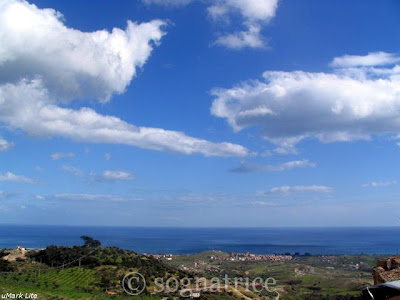
La tramontana is the name of the wind that gives us these great clothes-drying days; it also usually means that any rain clouds pass over us quickly without dropping anything.
Sure it puts a bit of a chill in the air too, but I’ll take it for the sake of our clothes…not to mention that it also gives us an excuse to start up a fire in the fireplace.
And I love a fire in the fireplace.
—————
[tags] memes, wind, tramontana, southern italy[/tags]
Badolato: Into The Heart of Calabria
Badolato Basics
My village, the birthplace of my great-great-grandfather, is Badolato, and it’s located between the Ionian Sea and the Serre Mountains in Calabria, the toe of Italy’s boot.
Badolato, the meaning of which is in dispute (sorry, only in Italian) was founded in 1080 by conqueror and first Duke of Calabria Robert Guiscard, who along with his brother, took over southern Italy and Sicily for the Normans around that time.
Like many villages of this period, Badolato was built on a hilltop about 5 kilometers from the sea with a good view of any approaching ships. Staying too close to the water was considered dangerous not only because of potential invasion–the southernmost part of the peninsula was the gateway to the entire territory now known as Italy and the rest of Europe–but also because of malaria, which was quite common as some of the area was swampland.
View of Badolato Superiore from the winding road leading up to the village.
And so, Badolato was built as a walled city, encircled by stone and guarded by three watchtowers, one of which is still partially standing (below); the town crest honors these watchtowers and the village’s medieval history.
Many of the original walls around the village as well as the old gates that sealed off the city from invaders also remain, but a castle on a hill that was once the town’s centerpiece (thus the name of the main square Piazza Castello) had to be torn down in the 1970s for safety reasons. Previously, it had cast a shadow on all that was below it, as castles are wont to do.
The piazza is now alternately called Piazza Fosso—fosso referring to the huge hole left behind by removing the hill and castle (it didn’t create a hole really, only leveled off the hill the castle had been on).
Political, social, and agricultural history
As rulers changed throughout southern Italy (German, French, Spanish, Turk, Austrian, Bourbon) Badolato felt each influence in turn, which you can hear in Badolatese, the main tongue spoken around here (a version of the Calabrian/Sicilian language, which some (mistakenly) call a dialect), and taste in the traditional Calabrian cuisine, noted for its fondness for the peperoncino, brought back to Italy by Columbus, although also widely used by Arabs who settled here.
Badolato soon became one of the most prominent and wealthiest cities in what is now southern Italy, swelling to a population of 8,000 (some estimates say up to 12,000) and boasting the palazzi of some of the most influential families in southern Europe, mostly due to production of olive oil, wine, and citrus fruit.
The family of the former baron of Badolato still owns a palazzo or two (although they don’t live here full-time) as well as a grand villa that sits on a huge chunk of the land surrounding the village. Almost all of the land around Badolato is still farmed, including that of the former baron, but most of it is was broken into smaller plots as the feudal system died down around the turn of the 20th century.
Incidentally, on the bigger plots, some families built workhouses (no plumbing, electricity, etc.), but still today it is rare for Calabrians to consider actually living on that kind of open land (most prefer village life and traveling by car or by foot to their land). Indeed getting permits to build is difficult as the land is zoned agricultural. Unless it has some existing structure (at least the remains of a wall!), it’s illegal to build a house on these land plots–which means no subdivisions in Calabria’s future. No complaints here.
Religious heritage
Badolato’s importance and deep religious and spiritual history are represented by its 13 churches and 17th century Convento Santa Maria degli Angeli, once a monastery but now a drug and alcohol rehabilitation treatment center; residents produce their own food on site and even operate a restaurant.
Convento nestled among olive trees
(You may remember this old monastery from the Easter procession)
Some say that it’s possible that the Holy Grail was transported here and may still be buried underground somewhere. In 1070, a group of Calabrian monks went to France and established the Ordre de Sion, which later became the Priory of Sion of Dan Brown’s Da Vinci Code fame–said to be the keepers of the Grail. The Calabrian monks returned to Calabria in 1090 but no one knows what, if anything, they brought with them from France; could they have incorporated valuable Christian artifacts into the underground ducts and tunnels of a blossoming Catholic stronghold called Badolato?
Effects of emigration
Like many southern Italian towns, Badolato was a victim of emigration, largely abandoned during two major waves of flight: the first in the early twentieth century (when my family left) and the second after World War II.
In both instances, emigrants were looking for better opportunities, but especially after the second World War when southern Italy was truly war-torn and downtrodden; my 82-year-old neighbor has sung for me a children’s rhyme that complained to Il Duce, Benito Mussolini, that they were living the day without bread and the night without lights (u jornu senza pane, la notte senza luce). A flash flood that wiped out a part of the village in the 1950s surely made the decision to leave easier for many.
Badolatesi fled to, among other places, the United States, Canada, Argentina, Brazil, Germany, Switzerland, and Australia, many leaving behind their homes with only whatever they could carry, never to return.
Others moved just down to the coast, where Badolato Marina was being built in the 1950s–living nearer to the water was now considered safe, plus coastal life was also more convenient with the railroad and highway running through there.
Indeed, P’s mom remembers where there wasn’t even a paved road leading down from the mountain village to the sea–I’ve yet to walk the path, but it’s still there–and anyway, there were only a handful of cars in the village even in to the 1960s, so you can that imagine folks tended to stay close to home.
Because of this mass emigration, the population of Badolato Superiore now stands at about 350 (total population with Badolato Marina is around 4000). This set-up is quite common throughout southern Italy, by the way, so that you’ll often see a “Superiore” town up on the hill/mountain, and its counterpart closer to the sea with “Marina” or “Lido” after the name.
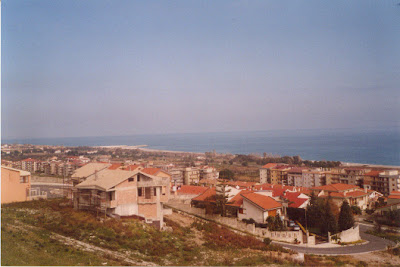 Badolato Marina
Badolato Marina
(Sorry for the poor quality here; it’s an old scanned photo of mine)
The Ship of Kurds
Badolato had fleeting hope of a boom just after Christmas 1997 when 825 Kurdish refugees landed on its shores; this made international news and you can read more about it here (the man on the left in the third photo is my vicino Giuseppe!).
The Badolato community welcomed the Kurds as potential workers and young revitalizers of the old town. The new immigrants are mostly gone now, though, either deported or having left for Germany, France, or elsewhere in the EU for work.
Still, Badolato remains one of the most involved immigration centers in all of Italy in so far as welcoming migrants and helping them with housing, health care, work, and psychological adjustment to life in a new country; one of my translation contracts with the local health care agency involves a special EU project to include cultural and linguistic mediators in this process.
Current and Future Badolato
And yet Badolato remains largely empty, like the village Farfallina wrote about, although the population swells enormously in August when many return to their hometown from Germany, northern Italy, etc., for ferie–Calabria, generally, is quite a hot spot for Italians and other Europeans looking for great, clean beaches.
Even the New York Times agrees.
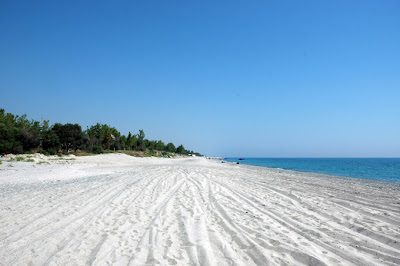 Photo © Franco Muìa
Photo © Franco Muìa
Badolato is undergoing a revitalization, though, as there have already been quite a few properties sold to international buyers over the years; casa by casa things are looking more lived in, although I’m the only year-round foreigner who lives here (Badolatesi would say the transplants from Genoa, Naples, and elsewhere in Italy are also stranieri, but I’m the only non-native Italian).
There is a lot of potential here for tourism, as you can probably imagine, although there would need to be a lot of infrastructure work done first–getting here and getting around isn’t always easy. No one wants to commercialize the town to the point that it’s another Siena or Cortona, overrun with tourists, but a few more visitors, a few more people who want to experience the real Italy complete with women carrying baskets on their heads?
Well that would be nice.
We may not have much support from the government, but we do have green mountains, a clear blue sea, fresh mountain air and water, warm souls, and delicious, fresh food, and for me, that’s certainly plenty.
Final Notes
For those of you who have made it this far (thank you!) and still want more, you can see more photos under the Scenes from Village Life label, my first Virtual Tour, and the two most recent posts: Destination Calabria: Photo Tour of a Medieval Village (Part I) and (Part II).
And if you want to plan a trip, just let me know!


